How to Grow Celery for Beginners
Get a step-by-step guide on How to Grow Celery for Beginners. We will cover how to plant, water, weed, care for an harvest all the way to your kitchen. When learning how to grow vegetables the more research you do the better. Get ready for a kitchen full of celery this growing season!
Research what you can when learning gardening 101 so you can fill it and your kitchen with vibrant organic produce.
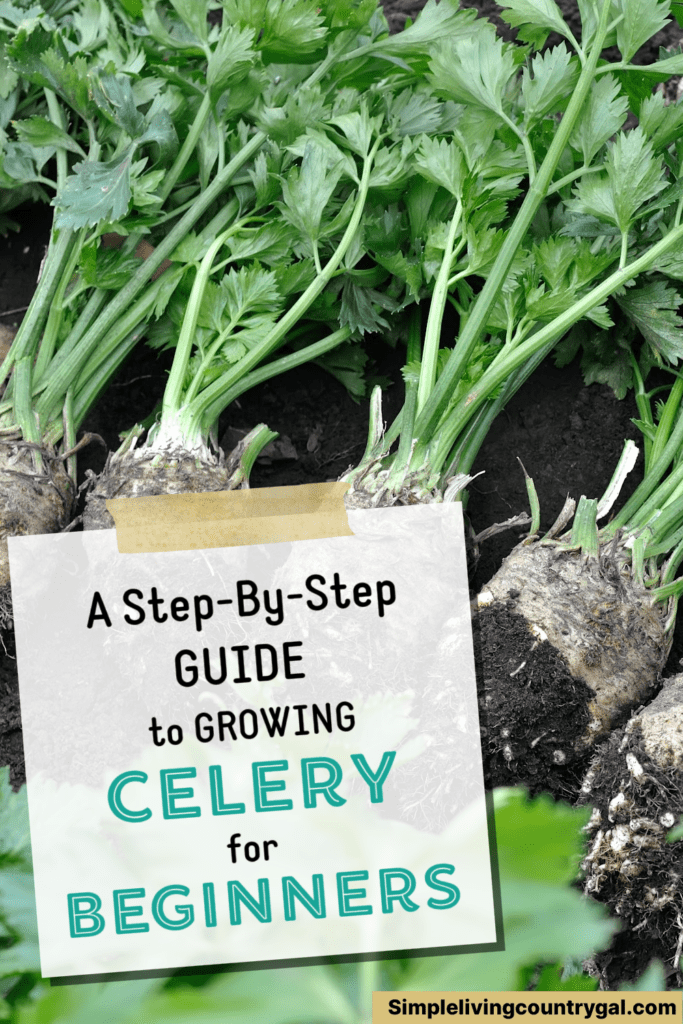
Celery is a great vegetable to eat on its own or add to your favorite recipes. Not only that, but home-grown celery has much more flavor than what you find at the grocery store and it doesn’t contain all the pesticides and chemicals of store-bought celery.
Where you live plays a significant roll in the best time to plant. Cooler regions should plant in early spring, but warmer regions should wait until mid- to late summer.
Celery can be a little difficult to grow for beginner gardeners, but since it’s so versatile in the kitchen, it can be worth the effort. Celery is perfect for soups, stews, stir-fries, salads, and as a healthy snack.
Celery prefers cooler weather and it’s a long-season crop, taking up to 140 days to grow. There are some short-season varieties available.
Celery can be a little challenging to grow because you’ll need to start seeds indoors; transplants are hard to find and sometimes don’t succeed. It’s also inclined to bolt in cold weather.
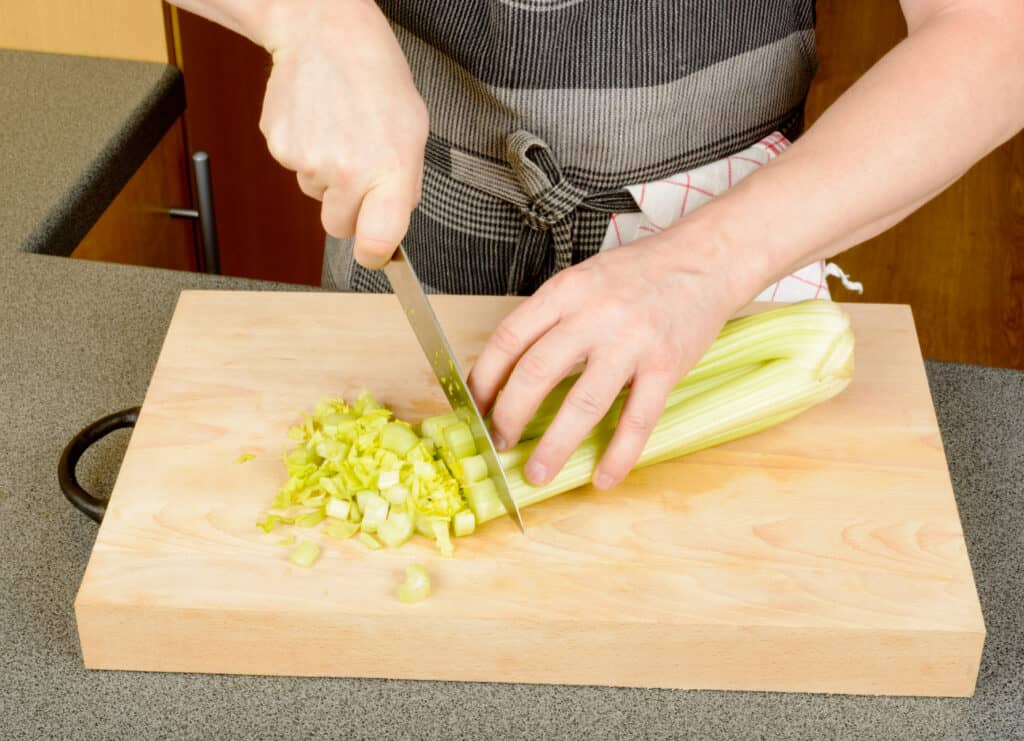
There are two main types of celery available:
· Trenching Celery – This will require mounding the soil against the stems as they grow in order to produce crisp, pale stalks. To make this easier, it’s usually best to plant celery in a trench, but you can help the blanching process along with cardboard tubes or pipes.
· Self-Blanching Celery – You won’t need any of the extra steps above, making it easier to grow. And it will taste just as good.
Within those types, there are a few varieties to choose from:
· Afina – tall, slender stalks that grow up to 30 inches in height. They are dark green and quick growing, usually about 60 days to maturity.
· Conquistador – this is more tolerant of high temperatures and water shortages.
· Golden Self Blanching – an heirloom dwarf variety with stringless stalks. This is a great option for smaller garden spaces.
· Utah 52-70R Improved – perfect for gardens with limited space. It will grow to about 18 inches tall and it is disease resistant.
Seed, Bulb, or Plant?
Celery is grown from a seed, best planted indoors then transplanted outdoors when the time is right. For a spring crop, start your seeds 10 to 12 weeks before the last frost of spring. For a fall crop, you’ll want to transplant them before the first frost of fall so start seeds 10 to 12 weeks before the first frost.
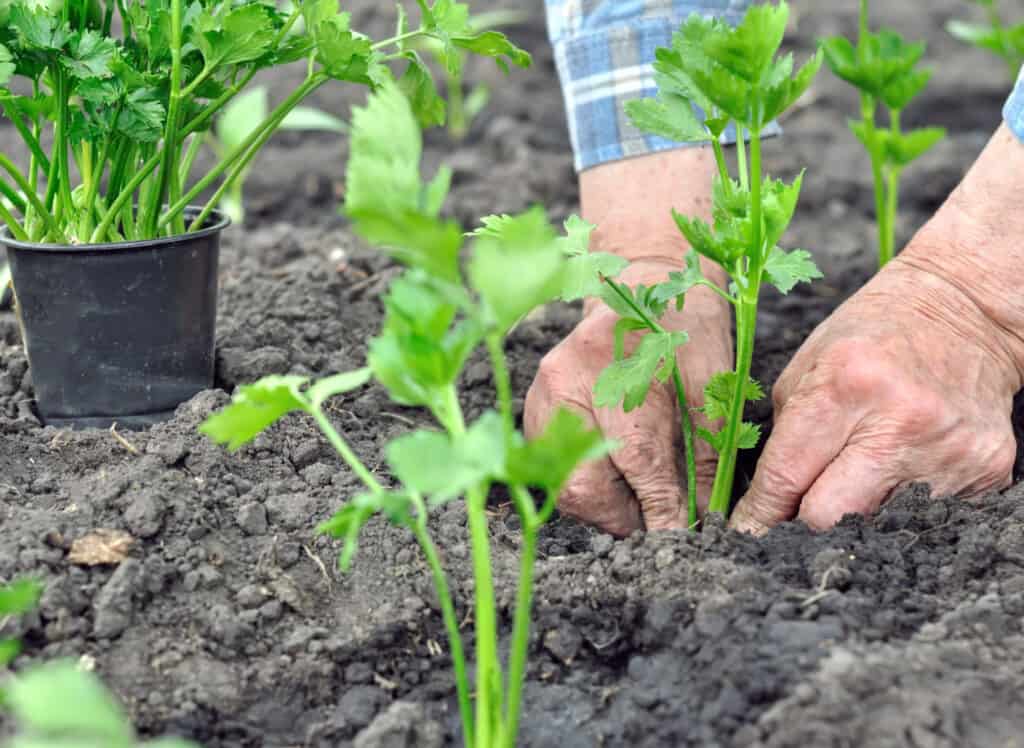
What You Need to Grow Celery
Celery prefers cooler temperatures, plenty of sunlight, and compost-enriched, moisture retaining soil. Find a spot in your garden where you can provide these things before planting.
When to Plant Celery
Cooler temperatures help celery stalks retain moisture, which provides most of their taste and crispness. If you’re planting in a cooler region, early spring is the best time to plant, right after the last frost. If you live in a warmer region, plant in mid- to late summer. Remember to start seeds indoors and allow 10 to 12 weeks for seed germination before transplanting outdoors.
Temperature
Celery prefers temperatures that are cool and comfortable, not too hot and not too cold. Between 60° and 70° F. These temperatures need to remain consistent throughout the growing season so plant at a time when you can enjoy these temperatures for a few months.
Sun
Celery prefers full direct sunlight so find a spot that receives about 8 hours of sunlight per day.
Soil
Celery does well in compost-enriched soil with a pH between 5.8 and 6.8. Loosen the soil to 12 to 15 inches deep with a garden fork or tiller. Then, mix in 2 to 4 inches of aged manure or compost. You can also choose to use a 5-10-10 fertilizer instead. The soil should also retain water to the point of being wet, but not muddy. It should drain away excess moisture, but not too quickly.
Water
Celery prefers wet soil, not damp and not muddy. There’s a fine balance to watering celery. Make sure to water consistently and keep the soil wet. If you feel you’ve overwatering, let the soil drain for a day. Otherwise, check the soil daily to see if it needs to be watered.
Fertilizing
It’s best to fertilize the soil before planting with manure, compost, or a 5-10-10 fertilizer then fertilize again twice during the growing season. This will help to maximize the yields.
Support
Celery will not need a support system. The heads will grow about 12 to 18 inches tall and they will be sturdy enough to not need support.
How Much to Plant
Plant 2 to 6 plants per person in your household depending on how often you plan to eat it.
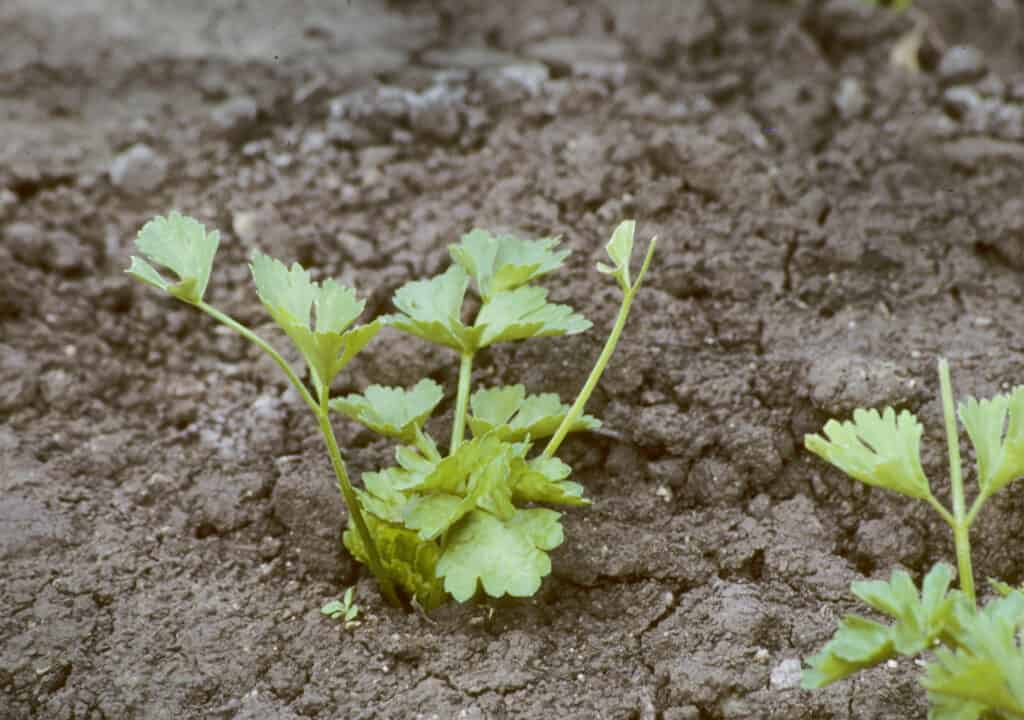
How Long Does Celery Take to Grow?
Celery has a long growing season. Depending on the variety, you can expect it to take anywhere from 4 to 6 months before it’s ready to harvest.
How to Plant Celery
Planting celery requires some advance planning. You’ll need to start the seeds indoors 10 to 12 weeks before transplanting them outdoors and you’ll need to plant in the proper season when it’s not too hot or too cold. Be sure to check the frost calendars in your area and plan to start your seeds accordingly.
Before planting, soak the seeds in warm water overnight to help speed up the germination. The seeds will be tiny so you may want to use a small spoon or other tool to assist. Fill your flats or pots with a good quality starting mix and pack it firmly until it’s level. Press the soaked seeds into the starter soil but do not cover with more soil; this will help the germination. The seeds should be about an inch apart so you may need to move them around a little.
Cover the flats or pots with plastic wrap to help retain moisture and create a humid environment for the seeds. Germination can take anywhere from 1 to 3 weeks so be patient.
After the seeds start to sprout, place a fluorescent grow light about 3 inches above the pots for 16 hours a day, not more because the seeds need some dark time too.
Maintain a temperature of 70° to 75° F during the day and 60° to 65° F at night. Mist the seeds and plants regularly to provide moisture and humidity.
When the seedlings are 2 inches tall, transplant them into individual pots or deeper flats with new potting soil. If you’re using flats, plant at least 2 inches apart.
Before transplanting outdoors, harden off the seedlings by slightly reducing water and placing them outdoors in a spot that is protected from the sun for just a couple of hours a day.
When the seedlings are ready to be transplanted outdoors, make sure the soil temperature reaches at least 50° F and that nighttime temperatures don’t go below 40° F. If the temperatures are too cold, it can cause bolting.
Plant the seedlings 8 to 10 inches apart and water thoroughly.
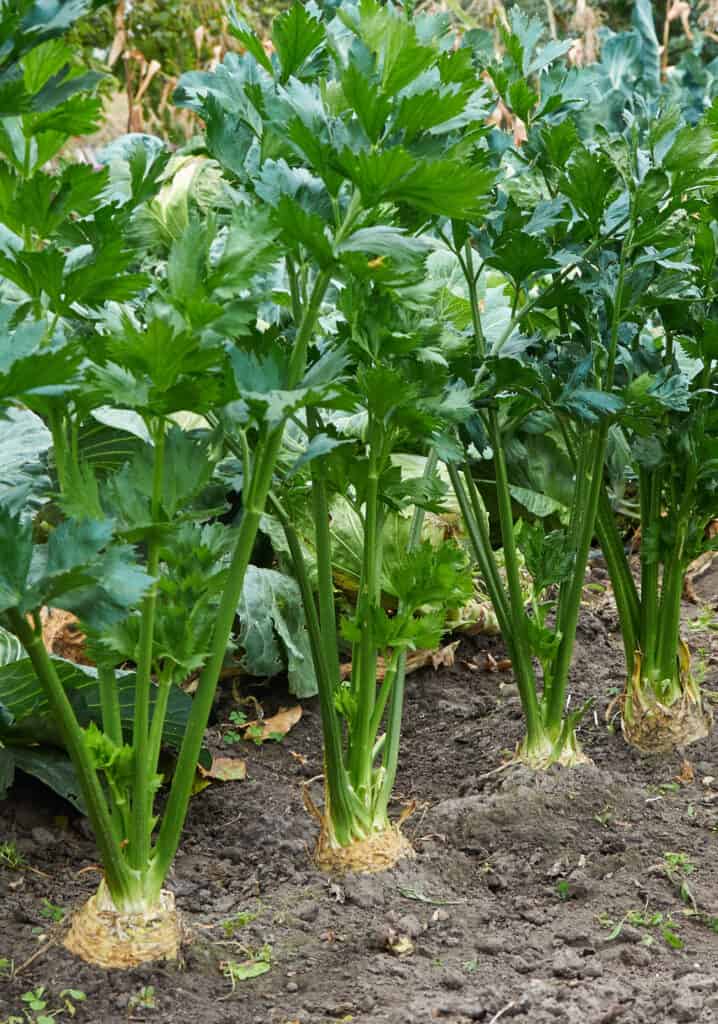
Provide plenty of water throughout the growing season and use row covers for the first 4 to 5 weeks to help prevent pests.
When plants are 6 inches tall, mulch around them to keep the soil moist. Side dress with compost and in the 2nd and 3rd months of the growing season, side dress with about 1 tablespoon of 5-10-10 fertilizer 3 t 4 inches from each plant.
Spacing
Seedlings should be planted 8 to 10 inches apart to allow for enough room for growth.
Depth
Plant seedlings to the base of the stem so that the roots are fully planted. Remember that you’ll need to mound around the stalks as they grow to ensure they are crisp so you may want to think about trenching the soil up to 8 inches deep before planting.
Growing Tips for Celery
· Weed the garden to keep it weed-free, but be careful of the roots. Celery roots are very shallow.
· Tie growing stalks together to them from sprawling.
· Once trenching varieties reach about a foot tall, start earthing them up and mound the soil about 3 inches each time.
· Wrap or cover the stalks (blanching) to eliminate a bitter taste and produce a nice pale green color. You can use anything that will keep out the light. Brown paper bags or cardboard boxes work well. Cover only the stalks, not the leaves.
· Grocery store celery is usually lighter in color and bigger than homegrown celery because it is grown in a greenhouse and usually contains pesticides.
· To crisp limp celery, soak it in cold water with a few slices of potato.
How to Harvest Celery
Celery can be harvested through summer and autumn until the first hard frost which will stop the growth. It’s possible that celery will overwinter if your climate is mild enough, which means you may see a few occasional stems throughout the cold months and starting to regrow in spring.
Plants can be harvested whole or you can cut or pick individual stems as required. This will keep the plants producing longer. You will only harvest the stalk, which is above ground. You can pick the stalks whenever you’d like, young celery is just as tasty as a more mature plant.
Harvest stalks from the outside in and you can begin harvesting them when they are about 8 inches tall.
If the soil is built up around it to maintain the temperature, celery can be kept in the garden up to a month. It will tolerate a light frost, but not consecutive frosts.
The darker the stalks become, the more nutritious they are, but they will also be tougher.
How to Store Celery
Place celery in a plastic bag and store in the refrigerator. It should stay fresh for several weeks. Celery can be frozen; cut the stalks into half-inch pieces and place in a freezer bag.
Diseases and Pests to Watch Out For
Like other fruits and vegetables in your garden, celery is susceptible to some pests and diseases. Although, you can control pests early on by covering with row covers for the first couple of months of growth. A few pests to watch out for include:
· Carrot rust flies – use row covers to prevent
· Earwigs – trap in a short can filled with a ½ inch of fish oil sunk in the ground so only the edge is slightly showing.
· Flea beetles – use row covers to prevent.
· Slugs and snails – handpick them off and avoid thick bark mulch.
Celery can be a little challenging for a beginner garden, but once it’s planted in the garden, it’s fairly easy to maintain with plenty of water, sunlight and proper fertilizing and mounding. The hardest part of growing celery is calculating the best time to start the seeds indoors to have them ready for transplanting outdoors at the right time.
If you properly calculate your planting around temperatures, the rest is fairly easy. And celery is something that you can use for a variety of recipes and freeze for use in the cold months in soups and stews. It’s a great option to try in your garden.
